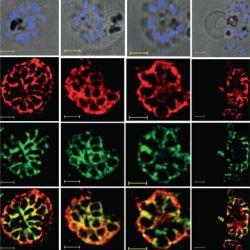
Plasmodium vivax is the most geographically widespread cause of malaria, with nearly 3 billion people at risk of infection, mostly in Latin America and Asia. There is no approved vaccine for P. vivax, and it is often referred to as a neglected parasite. A collaboration between the Rayner and Deane labs sheds new light on the function of the P. vivax Tryptophan Rich Antigens (TRAgs), a multi-gene family found in all Plasmodium species, but significantly expanded in P. vivax, which contains >30 TRAg genes. This research shows that multiple P. vivax TRAgs are expressed on the surface of the parasite stage that invades human red blood cells and that one, PVP01_0000100, binds red blood cells with a strong preference for the immature red blood cells that P. vivax prefers to invade. X-ray crystallography was used to determine the structure of the PVP01_0000100 C-terminal tryptophan rich domain, revealing a three-helical bundle that appears to be conserved across Plasmodium species and which the work confirms has a lipid-binding function. This paper showcases the highly collaborative environment at CIMR, and suggests a novel function for a pan-Plasmodium multi-gene family.

